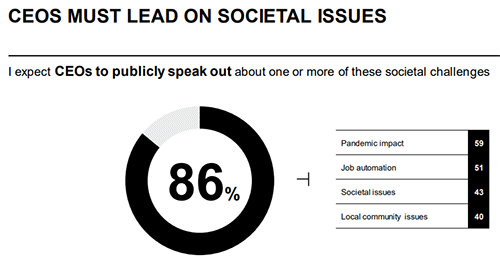How Can Purpose-Driven B2B Brands Avoid Virtue Signaling?
Today’s brands and marketers are often encouraged to take strong stances and boldly broadcast their values. There is a good reason for this: Customers increasingly want companies and their leaders to step up. According to Edelman’s 2021 Trust Barometer, 86% of people surveyed said they expect CEOs to publicly speak out on various social issues.

It’s not enough anymore to simply promote your products and services. For strong and sustained relationships, brands need to build deeper connections with customers, founded on trust. That means demonstrating that you share their values and priorities.
Sounds like a no-brainer, right? And many articles I’ve come across make it seem that way. But what often gets lost in this advice is the nuance of navigating sensitive topics that are often emotionally charged, and the potential for blowback. You don’t need to have a background in PR to understand the pitfalls of addressing serious societal problems as a brand.
To some extent, that’s part of the equation. Taking a meaningful stand as a company inherently means accepting some level of risk. But when determining your approach, it’s important to be mindful of how your message comes across.
What Is Virtue Signaling?
According to Oxford, virtue signaling is defined as “the action or practice of publicly expressing opinions or sentiments intended to demonstrate one's good character or the moral correctness of one's position on a particular issue.” Sometimes, brands are accused of virtue signaling when they openly and visibly support a cause without taking action to affect real change around said cause. When a company’s attempts to take a stand ring hollow, or come off as dubiously motivated or as moral grandstanding, they can be counterproductive.
Here are some tips for avoiding such a disconnect.
Connect your values to what your business does.
Any major stance your brand takes should be pertinent to what you do as a company. For example, if you sell SaaS for developers, it makes sense to openly champion the cause of creating career opportunities in coding for underserved communities. It makes less sense to challenge the working conditions of clothing factories in developing nations. The latter might be a perfectly worthy cause, but your audience is liable to become confused by the lack of overt relevance.
When the issues your organization addresses have a direct tie to the brand’s position and purpose, they’re likely to matter to and resonate with your customers, who will be more apt to see the support as authentic and genuine.
Of course, there are plenty of causes — such as sustainability and equality — that are relevant to basically every business and consumer on Earth.
Back up your words with action.
Nothing invokes the idea of “virtue signaling” quite like speaking passionately about a problem in our world and taking no evident actions to help solve it.
Gartner’s Augie Ray wrote about this misstep in a piece last year at Social Media Today, pointing out that many brands sent out flowery COVID-19 messaging simply for the sake of doing so.
“The problem with marketing messages that merely signal your brand's virtue without doing anything further is that they waste customers' time, and do little to impact your relationship. In fact, messages like that can do more to hurt brands because of what's missing — anything meaningful for customers,” he says.
Think twice about sending a message like this to your customers if it’s simply to check a box. Can you actually help them in a valuable way? Can you offer a next step for those in need? Can you show any evidence of actions your company is taking to make a difference?
Keep promotion of corporate responsibility initiatives in check.
There’s a fine balance. While you want to put actions behind your words, and you want that to be visible, you don’t want to come off as overly eager to promote your good deeds.
There’s no magical formula. But try to avoid going over the top with self-congratulatory posts about donations your company made or philanthropic work you’re doing. A mention here and there on social media, or a section on your website where people can learn for themselves, should be sufficient. Highlighting third-party coverage is great because you can let others do the talking.
On that note, I highly recommend encouraging your employees and executives to be more vocal than brand accounts and platforms. Brands themselves don’t care about causes; the people within those brands do. Let that shine through.
Focus your message of change on the positive (aspirational) more than the negative (critical).
No matter how closely you adhere to the steps above, taking a stand and moving outside of your brand’s comfort zone will inherently put you at risk of upsetting certain people.
One of the best ways to mitigate this is to maintain a positive and aspirational perspective on the issue you’re trying to address. Rather than lamenting the negative impacts and contributing factors, envision the better state that you’d like to achieve.
Virtuous Brands Can Send the Right Signals
Ultimately, one of the worst things that people behind a brand can do is let the fear of being perceived as “virtue signaling” prevent them from doing the right thing. If your workforce is united in its support to a cause that is relevant to what you do, and you’re backing up your words with action, no one can credibly accuse your company of being inauthentic in its values.
Instead, you’ll be on the right path to building trust by demonstrating that your brand is about more than making money.
Find more advice for hitting the right notes with your audience in an evolving business environment by subscribing to the LinkedIn Marketing Blog.





